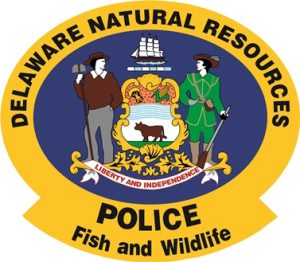Reminder for the week: State wildlife areas, forests monitored for criminal activity
DOVER – To achieve public compliance through education and enforcement actions that help conserve Delaware’s fish and wildlife resources and ensure safe boating and public safety, Fish & Wildlife Natural Resources Police officers between Feb. 20-26 made 1,410 contacts with anglers, hunters, boaters and the general public, including 57 vessel boardings for boating safety, hunting and fishing regulation compliance checks, issuing 23 citations. Officers responded to 34 complaints regarding possible violations of laws and regulations or requests to assist the public. An increased Fish & Wildlife Natural Resources Police presence continued at the C&D Canal Conservation Area and associated recreational trail.
Fish & Wildlife Natural Resources Police in the Community
• On Feb. 23, Fish & Wildlife Natural Resources Police officers attended a career fair at Smyrna High School, where they displayed the Operation Game Theft Trailer and presented information on Fish & Wildlife Natural Resources Police careers.
Fish & Wildlife Natural Resources Police Actions
Incident of note:
• On Feb. 24, Fish & Wildlife Natural Resources Police officers in New Castle and Kent Counties conducted targeted patrols of the state wildlife areas. Fifteen individuals were cited at multiple wildlife areas for trespassing after hours on a state wildlife area. Fines for each individual were $107, including court costs.
Citations issued by category, with the number of charges in parentheses, included:
Wildlife Conservation: Hunt gray squirrel out of season (1), and illegal sale of wildlife parts (1).
Public Safety: Possession of marijuana (2).
Other: Trespassing after hours on a state wildlife area (18), and dumping on a state wildlife area (1).
Are you AWARE?
Fish & Wildlife Natural Resources Police remind visitors to state wildlife areas, fishing ponds, boat ramps and piers and to state forests that these areas are multiple-use public recreational areas monitored for criminal activity. State forests are also monitored by Fish & Wildlife Natural Resources Police.
“Public use of state-owned wildlife areas and hunting, boating and fishing access areas and of state forests is intended for law-abiding anglers, boaters, hunters, birdwatchers and other outdoor enthusiasts to enjoy appropriate recreational outdoor activities,” said Sgt. John McDerby, Fish & Wildlife Natural Resources Police. “Criminal activities are not tolerated in these areas, including trespassing after hours, vandalism, drug and excessive alcohol use, illegal weapon possession or use and inappropriate public sexual conduct. Those caught abusing and misusing these areas through illegal activities will be prosecuted.”
The following rules also apply to Division of Fish & Wildlife properties:
• State wildlife areas, fishing piers and boat launching facilities and state forests are closed to the public from sunset to sunrise unless a person is actively and lawfully engaged in fishing, hunting or boating in accordance with state regulations and individual area rules.
• Operating motor vehicles – including motorcycles, cars, trucks and SUVs – off established roadways in state wildlife areas is illegal.
• Operating a motor vehicle that is not licensed for use on established public roadways – including ATVs – is prohibited both on and off-road on state wildlife areas.
• Camping, swimming, target shooting (including paintball), fires, dumping and littering are prohibited in state wildlife areas.
• Dog training is permitted only within established dog training areas or during open hunting seasons for the game animals that the dog is being trained to hunt.
• Hunting is permitted only in specified areas and only during designated hunting seasons.
• Firearms are prohibited on state wildlife areas from March 1 to Aug. 31, except during legal hunting seasons or as authorized by the Division of Fish & Wildlife.
• All of these sites have a carry-in, carry-out trash policy.
For more information on individual wildlife areas, including the rules and regulations specific to each wildlife area, wildlife area visitors are encouraged to review Delaware wildlife area maps. These maps are available in hard copy at DNREC’s Dover licensing desk in the Richardson & Robbins Building, 89 Kings Highway, Dover, and online at Delaware Wildlife Area Maps.
For more information on state forest rules and regulations, please visit State Forest Regulations.
DNREC’s Division of Fish & Wildlife recognizes and thanks the majority of anglers, hunters and boaters who comply with and support Delaware’s fishing, hunting and boating laws and regulations. Citizens are encouraged to report fish, wildlife and boating violations to the Delaware Fish & Wildlife Natural Resources Police by calling 302-739-4580. Wildlife violations may also be reported anonymously to Operation Game Theft by calling 800-292-3030 or online at http://de.gov/ogt.
Like Fish & Wildlife Natural Resources Police on Facebook, www.facebook.com/pages/Delaware-Fish-Wildlife-Natural-Resources-Police.
Follow Fish & Wildlife Natural Resources Police on Twitter, https://twitter.com/DE_FW_NRPolice.
Media contact: Sgt. John McDerby, Fish & Wildlife Natural Resources Police, 302-739-9913 or 302-354-1386.
-30-